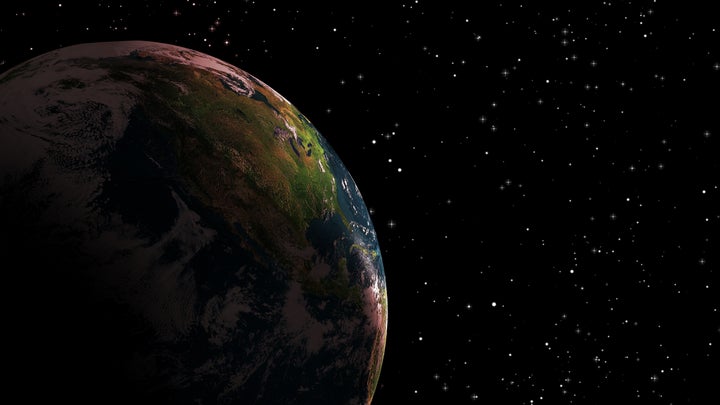
For hundreds of years, science has illuminated the mysteries of our universe, allowing us to conquer diseases, manipulate genomes, visit other planets and explore the wonders of space and time. But as a result of these profound and inarguable successes, science has also become the de facto cultural filter through which our broader societal norms, behaviors and institutions have developed and evolved. Newtonian physics established a physical reality composed of discrete and separate objects, operating according to predictable laws of time and space -- the universe as a giant billiard table. And Darwinian evolution established the biological world as a tooth-and-claw realm of scarcity, competition and "survival of the fittest." The end conclusions of this centuries-old scientific story is that we are accidents of the cosmos, living on a lonely planet in the cold depths of space, vying for limited resources in a frequently violent and tumultuous competition for supremacy. The implicit notion that we are walking husks for "selfish genes" pervades everything, from our economic and business institutions to our day-to-day interactions.
But an increasing number of scientific, philosophical and spiritual thinkers are arriving at the conclusion that this mechanistic take on the human story is fundamentally incomplete. Darwinian narratives of "survival of the fittest," and mechanistic Newtonian physics are increasingly being seen as elements of a far greater and richer tapestry. Quantum entanglement, or Einstein's "spooky action at a distance," demonstrates that our universe is interconnected in ways we might never have imagined, down to the most basic particle level. And the discovery of "mirror neurons" in humans and other primates demonstrates that simply seeing something happen to another creature lights up the same neurons as if it were happening to us. In a very real sense, we don't entirely distinguish between "the self" and others. And this is particularly true when witnessing suffering. Compassion and empathy seem to be hard-wired into us.
While inter-species and intra-species competition is an inarguable biological fact, we are discovering compelling new examples of connection, cooperation and community. In reality, we may have even misinterpreted Darwin. In his "The Descent of Man," published in 1871, Darwin only mentions the phrase "survival of the fittest" twice, while he mentions the word "love" 95 times. Dig beneath the surface of the natural world, and a tooth-and-claw narrative is clearly not the only one to be found. Bonobo apes, with which humans share more than 98 percent of their DNA, live in highly cooperative societies based on matriarchal structures. These and other recent scientific discoveries may prove pivotal in creating newer and more accurate cultural narratives. The Human Genome Project has revealed amazing commonalities among all living organisms, and the project has also found that there is greater genetic variability within a given race than between them. In short, in spite of superficial appearances, we are far more alike, at a fundamental genetic level, than we are different.
Even so, we retain hard-wiring from a primitive past that was directed toward survival-based judgments and assessments of others. Studies find that this programming leaves us constantly primed to gauge others as "in-group" or "out-group," based upon such criteria as race, gender, age and perceived cultural and socio-economic status -- and that such analyses occur within milliseconds. This tribalism can be surprisingly fluid and dynamic. In one study, teen boys were exposed to the art of either Kandinsky or Klee. Even though the boys were previously unfamiliar with either and had been randomly assigned to view the works of only one artist, the Kandinsky "gang" quickly showed a greater willingness to loan money to other Kandinsky in-group members. And the same proved true of the experimental Klee "gang."
Because such tribal-bonding is so dynamic and shifting, however, it is also highly malleable. Once recognized and understood, this hard-wiring can be consciously subverted. A measurable aversion to the image of a homeless person or drug addict can be rapidly transformed by an assignment to participate in a soup kitchen and choose appropriate menu items for people in need. In this way, out-group members almost instantaneously become fellow in-group members as part of a joint undertaking. The key to such subversion of tribalistic tendencies is that cross-group members must share a larger common goal, and have the support of recognized authority figures.
While competition and tribalistic bonding are inarguable aspects of our world, science increasingly makes clear that this is only one part of an expanding conceptual landscape. Our entire universe is profoundly interconnected, in ways that we are only beginning to decipher. This is true at the elementary particle level, at the genetic level, at the organism level and at a global level via the Internet. Ultimately, the same scientific milieu that helped form our current conflict-ridden cultural narratives may now be instrumental in defining not only a more productive world view, but a more accurate one.
Steven and Michael Meloan are authors of "The Shroud," a science-adventure novel exploring the spiritual impulse, tribalism and its manifestations in human behavior, and the intersection between science and spirituality:
http://www.TheShroud.net
http://www.facebook.com/TheShroudBook